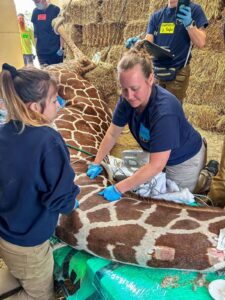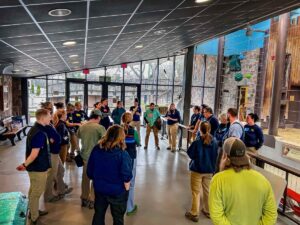
Kendi, a male reticulated giraffe at The Milwaukee County Zoo, is recovering well after successfully undergoing a complex surgery — due to a unique breeding injury — that has never been performed on the species. This historic achievement was the result of intense planning and a large, collaborative effort across multiple institutions and veterinary disciplines.

Kendi, 4, sustained a breeding injury — a laceration of the prepuce that became infected — which was visually identified by the Zoo’s animal care team on April 2. The prepuce is the moveable sheath of skin that covers the predominant male reproductive organ.
Kendi was attempting to breed with female member of the herd, Maya, 6. Maya and Kendi are a recommended pairing by the Association of Zoos and Aquariums (AZA) Giraffe Species Survival Plan® (SSP). Reticulated giraffes are listed as Endangered by the IUCN (International Union for Conservation of Nature) Red List. According to the veterinary advisors of the Giraffe SSP, while minor breeding injuries do occur in giraffes, they don’t typically require intervention — and this specific type of injury is believed to have never been seen before in the species.

The team first attempted to medically-manage Kendi’s injury through pain medication, antibiotics, and topical treatment, all of which proved unsuccessful. What happened next was the result of days’ worth of planning, preparation, and outreach. Kendi would first need to be immobilized (anesthetized), so the animal care team could better assess the injury and determine how to proceed.
However, giraffe immobilizations are high risk and no easy feat, due to their body conformation and associated unique physiology. Giraffes are the tallest land mammals in the world, with Kendi nearly 14 feet tall and weighing almost 2,000 pounds. Because of their large size, giraffes are challenging to move and position appropriately for anesthetic procedures. Giraffes also have a long way to fall when they’re anesthetized, which can lead to injuries. Their long neck is easily damaged during anesthesia induction or during a procedure if the neck is not properly supported and maintained when lying down. If giraffes develop neck problems during anesthesia, this can make them unable to get up, because they need to swing their head forward to propel themselves to their feet. Their long necks can also make blood pressure management and appropriate ventilation challenging when under anesthesia. To mitigate all these risks, the Zoo’s animal care team needed to be prepared for possible complications, with a plan to address those complications if they arose.
The Zoo’s animal care team contacted veterinary specialists for consultations and scheduled available consultants to come to Milwaukee to assist, including veterinary professionals from the UW-Madison School of Veterinary Medicine (a large animal surgeon, anesthesia team, and veterinary technicians), Henry Vilas Zoo (a veterinarian and veterinary technician), Kettle Moraine Equine Hospital and Regional Equine Dental Center (a large animal surgeon and veterinary technician), and others. A complete procedure plan was assembled (including anesthesia and surgery, compiling supplies, determining the order of events during the procedure, and assigning tasks to various people and areas). The Giraffe Barn also needed to be set up to ensure the team had the safest place for immobilization and recovery. The Zoo’s Grounds, Forestry, and Maintenance were instrumental in modifying part of the Barn, including adding extra padding to the stall where the procedure could be performed, aiding in positioning Kendi, and more.

Once the team was able to immobilize Kendi and assess his injury, they determined that a reefing — removal of a portion of the damaged prepuce with subsequent repair of the remaining prepuce — was needed, and it was performed without incident on April 11. The total time of the procedure, from anesthesia induction to reversal, was about two hours. According to reports, a reefing has never previously been performed on a giraffe, although it’s commonly performed on horses and cows.
Christy Rettenmund, Senior Staff Veterinarian for MCZ, notes, “Many of the people involved had never participated in a giraffe anesthetic procedure before, and those who had, hadn’t done one in our Giraffe Barn or with our particular set up. This was a new and very complex procedure for us. Being prepared for any eventuality is the key to reducing anesthetic risk in any species we work with, and that’s a big part of why Kendi’s procedure was so successful.”
Kendi’s postoperative care included pain medications and antibiotics. He’ll remain separated from the female members of the herd until July but does get to see them in the indoor habitat, socializing with them over the wall. While unusual, Kendi’s injury was actually sustained during typical breeding behavior, so there is a chance that it could occur again. However, the animal care team will be monitoring him closely once he’s allowed to resume breeding. The team doesn’t expect that this will affect Kendi’s ability to reproduce, but it’s difficult to know for certain.
Amos Morris, Director of MCZ, emphasizes, “The Zoo is incredibly proud of what the team was able to achieve, in partnership with the many consultants who didn’t hesitate to lend a hand and share their expertise on a challenging case. We are optimistic for our very special giraffe, Kendi, and his future.”
© 2025 Milwaukee County Zoo. All Rights Reserved | Privacy Policy